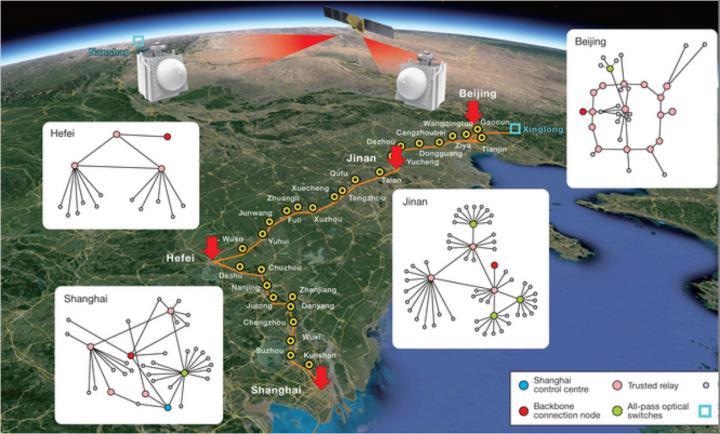Jan 7 2021
Researchers from China have set up the first-ever integrated quantum communication network, which incorporates more than 700 optical fibers on the ground and two ground-to-satellite links to enable quantum key distribution over a total distance of 4,600 km for users throughout the country.

Image Credit: University of Science and Technology of China.
Led by Jianwei Pan, Yuao Chen, and Chengzhi Peng from the University of Science and Technology of China in Hefei, the research team has described the latest progress toward the global, practical application of such a network for future communications, in the Nature journal.
In contrast to traditional encryption, quantum communication is regarded as unhackable and thus the future of secure transfer of information for power grids, banks and other sectors.
Quantum key distribution (QKD) forms the core of quantum communication and involves using the quantum states of particles, such as photons, to create a string of zeros and ones. Any eavesdropping between the sender and the receiver will alter this key or string and will instantly be noticed.
To date, the most commonly used QKD technology is based on optical fibers for transmissions across several hundred kilometers and ensures high stability yet substantial channel loss. Another main QKD technology is based on the free space between satellites and ground stations for transmissions over several thousand kilometers.
China launched the first-ever quantum communication satellite (QUESS, or Mozi/Micius) in 2016 and realized QKD with two ground stations located 2,600 km from each other. A more than 2,000-km-long optical fiber network was completed in 2017 for QKD between Beijing and Shanghai.
Reliable relays were used to integrate the ground-based fiber network and the satellite-to-ground links to serve over 150 industrial users across China, such as state and local banks, e-government websites and municipal power grids.
"Our work shows that quantum communication technology is sufficiently mature for large-scale practical applications."
Jianwei Pan, Professor, University of Science and Technology of China
In the same way, national quantum networks from different countries can be combined to set up a global quantum communication network, or this can be achieved if companies, universities and institutions join hands to standardize associated protocols, hardware, etc., added Pan.
In the past two years, the researchers thoroughly investigated and optimized the performance of various parts of the integrated network. For example, equipped with a higher clock rate and more efficient QKD protocol, the satellite-to-ground QKD currently has an average key generation rate of 47.8 kilobits per second—40 times greater compared to the earlier rate.
Moreover, the team has pushed the record for ground-based QKD to more than 500 km with the help of a new technology known as twin-field QKD (TF-QKD).
The next step for the researchers is to further widen the network in China by working with their international collaborators from Italy, Austria, Canada, and Russia. In addition, the researchers intend to create small-scale, economical QKD satellites and ground-based receivers, together with medium and high earth orbit satellites to realize all-time, 10,000-km-level QKD.
This study was supported by the National Development and Reform Commission of China, the provincial/municipal government of Shandong, Anhui, and Shanghai, China Banking Regulatory Commission, the Chinese Academy of Sciences, the Ministry of Science and Technology of China, and the National Science Foundation of China.
Journal Reference:
Chen, Y.-A., et al. (2021) An integrated space-to-ground quantum communication network over 4,600 kilometres. Nature. https://doi.org/10.1038/s41586-020-03093-8.